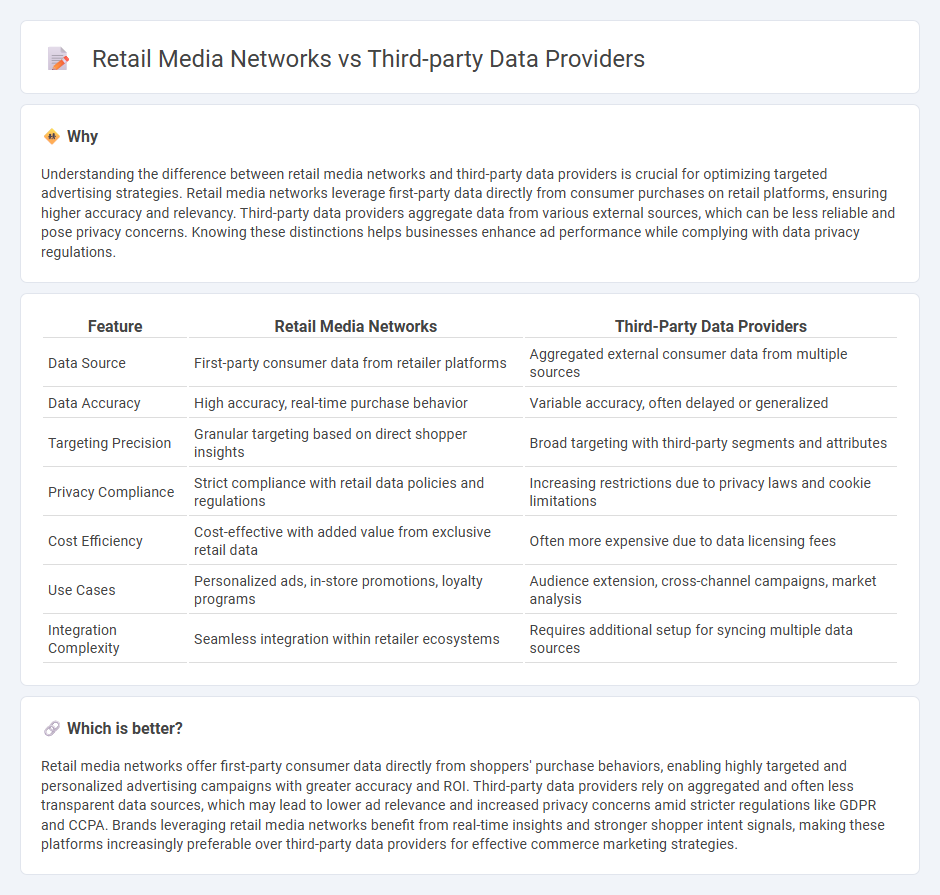
Retail media networks leverage first-party consumer data from retailers to deliver highly targeted advertising directly at the point of purchase, enhancing ad relevance and driving sales. Third-party data providers collect and aggregate data from multiple external sources, offering broader but less personalized audience insights for advertising and marketing strategies. Explore the advantages and challenges of retail media networks versus third-party data providers to optimize your commerce strategy.
Why it is important
Understanding the difference between retail media networks and third-party data providers is crucial for optimizing targeted advertising strategies. Retail media networks leverage first-party data directly from consumer purchases on retail platforms, ensuring higher accuracy and relevancy. Third-party data providers aggregate data from various external sources, which can be less reliable and pose privacy concerns. Knowing these distinctions helps businesses enhance ad performance while complying with data privacy regulations.
Comparison Table
| Feature | Retail Media Networks | Third-Party Data Providers |
|---|---|---|
| Data Source | First-party consumer data from retailer platforms | Aggregated external consumer data from multiple sources |
| Data Accuracy | High accuracy, real-time purchase behavior | Variable accuracy, often delayed or generalized |
| Targeting Precision | Granular targeting based on direct shopper insights | Broad targeting with third-party segments and attributes |
| Privacy Compliance | Strict compliance with retail data policies and regulations | Increasing restrictions due to privacy laws and cookie limitations |
| Cost Efficiency | Cost-effective with added value from exclusive retail data | Often more expensive due to data licensing fees |
| Use Cases | Personalized ads, in-store promotions, loyalty programs | Audience extension, cross-channel campaigns, market analysis |
| Integration Complexity | Seamless integration within retailer ecosystems | Requires additional setup for syncing multiple data sources |
Which is better?
Retail media networks offer first-party consumer data directly from shoppers' purchase behaviors, enabling highly targeted and personalized advertising campaigns with greater accuracy and ROI. Third-party data providers rely on aggregated and often less transparent data sources, which may lead to lower ad relevance and increased privacy concerns amid stricter regulations like GDPR and CCPA. Brands leveraging retail media networks benefit from real-time insights and stronger shopper intent signals, making these platforms increasingly preferable over third-party data providers for effective commerce marketing strategies.
Connection
Retail media networks leverage third-party data providers to enhance targeting accuracy by integrating external consumer insights with first-party shopper data. This combination enables precise audience segmentation, improving ad relevance and driving higher return on investment (ROI) for brands within the retail ecosystem. Collaboration between retail media platforms and data aggregators fosters enriched customer profiles, optimizing marketing strategies and sales performance.
Key Terms
Data Monetization
Third-party data providers aggregate consumer information from various external sources to sell detailed audience segments for targeted advertising, enabling businesses to enhance their campaign precision. Retail media networks leverage first-party shopper data collected directly from e-commerce platforms and POS systems to monetize customer insights within their owned digital ecosystems. Explore how these distinct data monetization strategies impact advertising effectiveness and revenue generation.
Audience Targeting
Third-party data providers aggregate extensive consumer information from diverse sources, enabling precise audience targeting through demographics, interests, and behaviors. Retail media networks leverage first-party data directly from their own shoppers' purchase and browsing history, offering highly accurate targeting based on real-time retail behavior. Explore how combining these data sources can optimize your audience targeting strategy and drive better campaign results.
Attribution
Third-party data providers offer broad audience insights by aggregating user information across multiple platforms, enabling precise attribution models that track consumer behavior beyond a retailer's environment. Retail media networks leverage first-party transactional data within their ecosystem, delivering highly accurate attribution by connecting ad impressions directly to in-store or online purchases. Explore how combining these data sources can elevate your attribution strategy for more effective marketing outcomes.
Source and External Links
What Is First-Party Data and Third-Party Data? Expert Guide - Third-party data is collected and compiled by external data providers from varied sources like public records and surveys, then sold to companies to enrich their customer databases and expand their audience reach.
What Is Third-Party Data? Why It Matters and How to Use It | 97th Floor - Third-party data is gathered by entities with no direct user relationship, often from public records or social media, and when combined with first-party data, it helps companies better understand and segment customers for targeted marketing.
Third-party data | Acxiom - Third-party data consists of customer information collected lawfully by data providers who have no direct customer relationship; these datasets support enhanced customer segmentation, personalization, and marketing in the evolving AI and cookie-less landscape.
 dowidth.com
dowidth.com